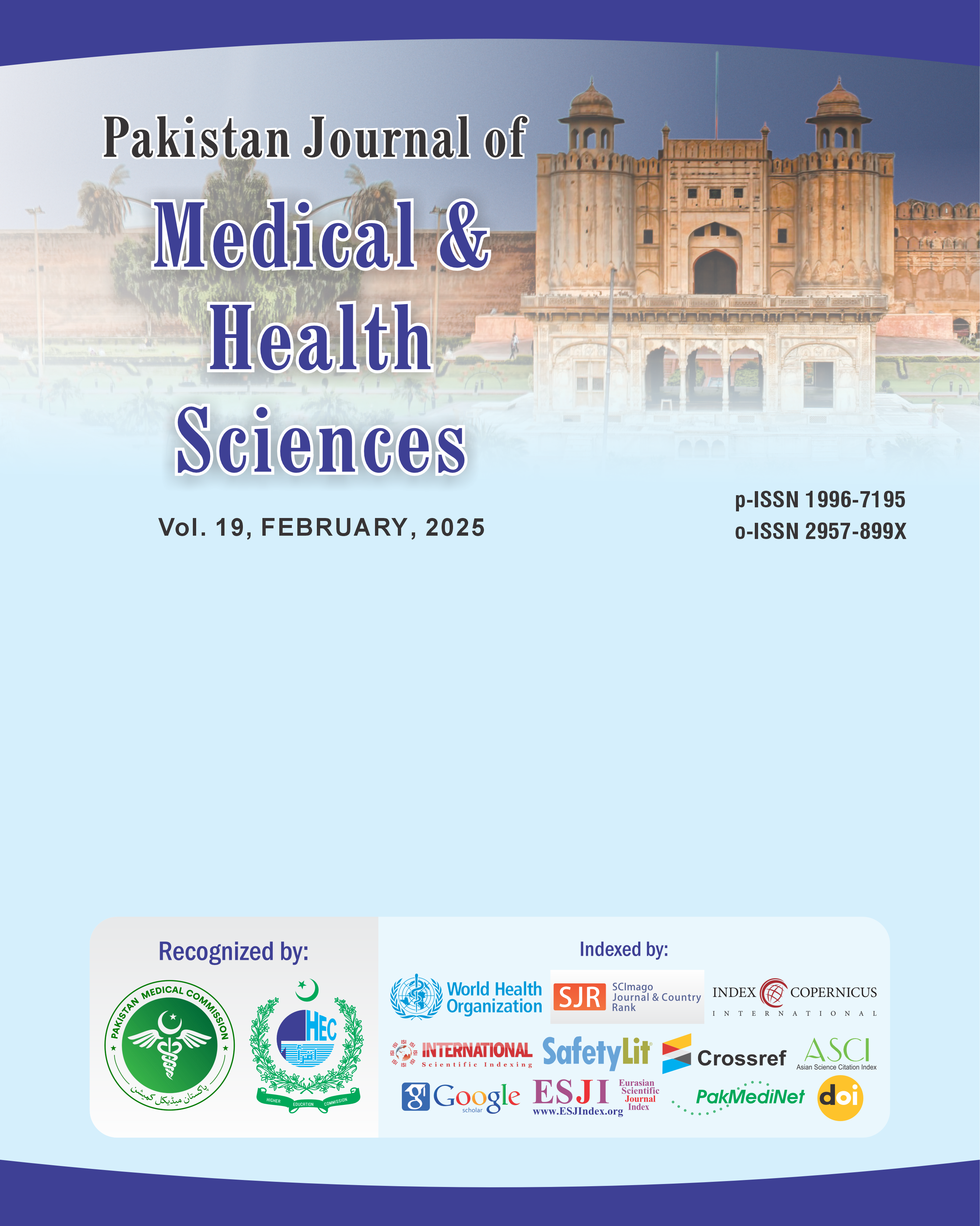Risk Factors for Wound Infection after Open Appendectomy in Acute Appendicitis Patients - A Cross-Sectional Clinical Study
DOI:
https://doi.org/10.53350/pjmhs02025192.2Keywords:
Keywords: Postoperative, Prophylactic Antibiotics, Appendectomy, Infection, Intra-abdominal.Abstract
Background: Open appendectomy is one of the most common surgical procedures, and surgical site infections (SSIs) are among the most common complications after open appendectomy, especially in resource constrained settings. The key predisposing factors could be identified to improve clinical outcomes and decrease postoperative morbidity.
Aim: To identify the clinical, demographic, and intraoperative risk factors predictive for surgical site infections among patients undergoing open appendectomy.
Methodology: A prospective clinical study was performed on 25 patients who were emergently operated for acute appendicitis through open appendectomy in the patients attending Jinnah Hospital Lahore. Demographics, comorbidities, presentation time, operative details and antibiotic administration were recorded. Incidence of SSIs in patients were followed for 30 days after the operation. Data were analyzed using SPSS version 26, p < 0.05 was regarded as significant.
Results: Out of 25 patients, 7 (28%) developed surgical site infections. Delaying to presentation beyond 48 hours (p = 0.019), presence of a perforated appendix (p = 0.021), a BMI > 25 kg/m² (p = 0.041), diabetes mellitus (p = 0.029), operative time > 60 minutes (p = 0.010), and inadequate antibiotic prophylaxis timing (p = 0.035) were significant risk factors for SSIs. However, smoking was present in a higher proportion in the infected group and did not reach statistical significance (p = 0.280).
Conclusion: The results of this study illustrate that the risk of SSIs after open appendectomy is elevated by the presence of clinical comorbidities, especially diabetes and the presence of obesity, late surgical intervention, perforation, and inadequate perioperative antibiotic management. Prophylactic antibiotics, early diagnosis, optimal timing of surgery are critical in minimizing postoperative wounds complications.
References
Bhangu A, Soreide K, Saverio SD et al (2015) Acute appendicitis: modern understanding of pathogenesis, diagnosis, and management. Lancet 386:1278–1287 10.1016/S0140-6736(15)00275-5
Asarias JR, Schlussel AT, Cafasso DE et al (2011) Incidence of postoperative intraabdominal abscess in open versus laparoscopic appendectomies. SurgEndosc 25:2678–2683 10.1007/s00464-011-1628-y
Lim SG, Ahn EJ, Kim SY et al (2011) A clinical comparison of laparoscopic versus open appendectomy for complicated appendicitis. J Korean SocColoproctol 27(6):293–297 10.3393/jksc.2011.27.6.293
de Almeida Leite RM, Seo DJ, Gomez-Eslava B et al (2022) Nonoperative vs Operative Management of uncomplicated Acute appendicitis a systematic review and Meta-analysis. JAMA Surg 157(9):828–834 10.1001/jamasurg.2022.2937
Fike FB, Mortellaro VE, Juang D et al (2011) The impact of postoperative abscess formation in Perforated Appendicitis. J Surg Res 170(1):24–26 10.1016/j.jss.2011.03.038
Burini G, Cianci MC, Coccetta M et al (2021) Aspiration versus peritoneal lavage in appendicitis: a meta-analysis. World J Emerg Surg 16(1)
Cho J, Park I, Lee D et al (2015) Risk factors for postoperative intra-abdominal abscess after laparoscopic appendectomy: analysis for consecutive 1,817 experiences. Dig Surg 32:375–381 10.1159/000438707.
Levin DE, Pegoli W (2015) Abscess after Appendectomy: predisposing factors. AdvSurg 49:263–280 10.1016/j.yasu.2015.03.010
Schlottman F, Sadava EE, Pena ME et al (2017) Laparoscopic appendectomy: risk factors for postoperative Intraabdominal Abscess. World J Surg 41:1254–1258 10.1007/s00268-017-3869-y
Guy S, Wysocki P (2018) Risk factors for intra-abdominal abscess post laparoscopic appendicectomy for gangrenous or perforated appendicitis: a retrospectivce cohort study. Int J Surg Open 10:47–54 10.1016/j.ijso.2017.12.003
Lasek A, Pedziwiatr M, Wysocki M et al (2019) Risk factors for intraabdominal abscess formation after laparoscopic appendectomy – results from the Pol-LA (Polish Laparoscopic Appendectomy) multicenter large cohort study. WideochirInne Tech Maloinwazyjne 14(1):70–78
Tartaglia D, Fatucchi LM, Mazzoni A et al (2020) Risk factors for intra-abdombinal abscess following laparoscopic appendectomy for acute appendicitis: a retrospective cohort study on 2076 patients. Updates Surg 72:1175–1180 10.1007/s13304-020-00749-y
Alfonso V, Gomez F, Lopez A et al (2003) Value of C-reactive protein level in the detection of necrosis in acute pancreatitis. GastroenterolHepatol 26(5):288–293 10.1016/S0210-5705(03)70358-
Kimbrell AR, Novosel TJ, Collins JN et al (2014) Do postoperative antitbiotics prevent abscess formation in complicated appendicitis? Am Surg 80(9):878–883 10.1177/000313481408000921
Daskalakis K, Juhlin C, Pahlman L (2013) The use of pre- or postoperative antibiotics in surgery for appendicitis: a systematic review. Scand J Surg 103(1):14–20 10.1177/1457496913497433.
Hughes MJ, Harrison E, Paterson-Brown S (2013) Post-operative antibiotics after appendectomy and post-operative Abscess Development: a retrospective analysis. Mary Ann Liebert 14(1)
Hartwich J, Luks FI, Watson-Smith D et al (2016) Nonoperative treatment of acute appendicitis in children: a feasibility study. J PediatrSurg 51(1):111–116 10.1016/j.jpedsurg.2015.10.024.
Armstrong J, Merritt N, Jones S et al (2014) Non-operative management of early, acute appendicitis in children: is it safe and effective? J PediatrSurg 49(5):782–785 10.1016/j.jpedsurg.2014.02.071.
Wilms IM, de Hoog DE, de Visser DC et al (2011) Appendectomy versus antibiotic treatment for acute appendicitis. Cochrane Database Syst Rev 9(11):CD008359.
Downloads
How to Cite
Issue
Section
License
Copyright (c) 2025 MUHAMMAD RASHID, MUHAMMAD ASADULLA KHAWJA, MOMINA SAJJAD, AYESHA SAJJAD

This work is licensed under a Creative Commons Attribution 4.0 International License.


